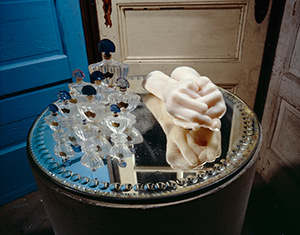
Cell II
Louise Bourgeois
Cell II, 1991 (detail)
Painted wood, marble, steel, glass, and mirror, 210.8 x 152.4 x 152.4 cm
Carnegie Museum of Art, Pittsburgh
Photo: Peter Bellamy, © The Easton Foundation/VEGAP, Madrid
“When I began building the Cells, I wanted to create my own architecture, and not depend on the museum space, not have to adapt my scale to it. I wanted to constitute a real space which you could enter and walk around it.” —Louise Bourgeois[1]
In the last two decades of her life, Louise Bourgeois (b. 1911, Paris; d. 2010, New York) devoted herself to the creation of her most innovative and challenging sculptural works, a series of architectural spaces called Cells. In the early 1980s, Bourgeois moved her workspace from her house in Chelsea, Manhattan, to a large studio in a converted garment factory in Brooklyn. This gave her more freedom to change the scale of her works, giving rise to the Cells series.
The Cells series are installations that consist of enclosed spaces into which the viewer may enter in some instances, but may also be excluded from it.[2] They usually contain a mixture of made and found objects, including things that are dear to the artist, objects that have particular historical significance for her, and doors or other architectural structures that she collected from the neighborhood streets. The term “cell” originated during the preparations for a 1991 exhibition, where she presented the first six of these works.[3] Bourgeois made about sixty Cells from 1989 to 2008. For her, the word cell had many connotations, from the biological cell of a living organism to the isolation of a prison cell or monastic chamber.[4]
Bourgeois often referred to her pieces as autobiographical, especially related to her own childhood. In Cell II (1991), the viewer can only peer into a small room, framed by hinged wooden doors, to see a mirrored tray on which are arranged nine empty perfume bottles and a pair of tightly clenched marble hands. The setting and these objects contribute to the effect of a very private place, where she incorporates real objects from her life. The perfume bottles are not random; they are Shalimar, a scent that Bourgeois herself used and her mother wore throughout her childhood.
1. Louise Bourgeois, “Red Rooms,” in Louise Bourgeois: Oeuvres récentes/Recent works, Marie-Laure Bernadac, ed., exh. cat. (Bordeaux: Musée d’art contemporain de Bordeaux and Serpentine Gallery, London, 1988), p. 38.
2. http://www.tate.org.uk/art/artworks/bourgeois-maman-t12625/text-summary
3. http://garagemca.org/en/event/louise-bourgeois-structures-of-existence-the-cells
4. http://www.collectortribune.com/2015/08/04/louise-bourgeois-structures-of-existence-the-cells-at-garage-museum-moscow/
Preguntas
Show: Cell II (1991)
Describe this sculpture as carefully as you can. What are your initial reactions? Does this sculpture look like or make you think of anything you have seen before? If so, what?
Imagine that you can get inside the Cell II. How would you feel? Do you think it is a comfortable or uncomfortable place to be? Explain. Bourgeois often referred to her pieces as autobiographical, especially related to her own childhood. Although she did not elaborate on the individual meaning of each object, what do you think their meaning might be? What could be the relationship between the objects and the doors surrounding them? Why do you think Bourgeois chose these particular objects to represent a biographical moment?
On top of the mirrored tray we see ten bottles of Shalimar perfume, a scent that Bourgeois and her mother both wore. Imagine that you can open one of the bottles. What would they smell like? Why?
Bourgeois gave this artwork a simple name. Create a list of your own possible titles. Why did you choose them?
